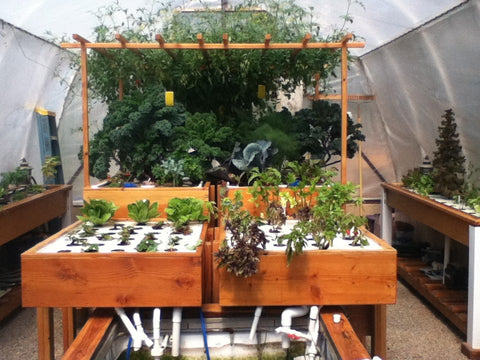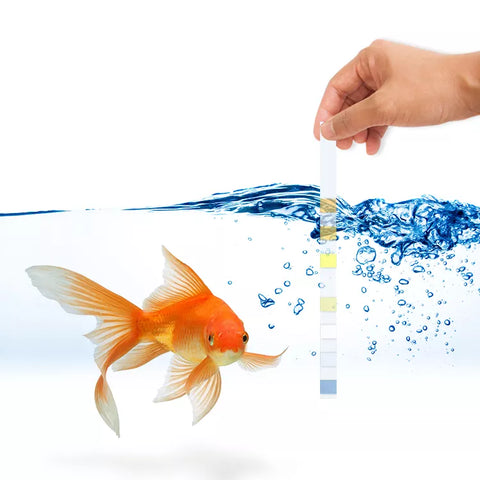Central to the success of any aquaponics setup is the delicate balance between the number of fish and the variety and quantity of plants. This aquaponics balance, known as the fish-to-plant ratio, plays a crucial role in ensuring optimal growth, nutrient cycling, and overall health of the system.
In this article, we will discuss the fish-to-plant ratio in aquaponics, explore its significance, methods of calculation, and strategies for maintaining balance. Understanding and implementing the ideal fish-to-plant ratio is essential for maximizing yields and fostering a thriving aquaponics system, so join us and we'll unravel the secrets behind achieving harmony in your aquaponics garden.
The Importance of Maintaining a Balanced Aquaponics Fish to Plant Ratio
In aquaponics, the delicate balance between the number of fish and the quantity and variety of plants is essential in maintaining its stability. This balance, known as the fish-to-plant ratio, is crucial for several reasons:
- Maintaining the right ratio ensures that there are enough fish to produce the nutrients that are necessary for plant growth without overloading the system with too much waste.
- A balanced system promotes efficient nutrient cycling.
- A balanced fish-to-plant ratio helps prevent issues like nutrient deficiencies or too many nutrients, water quality problems, and fish or plant overcrowding, which can affect the health and productivity of the system.
- Maintaining a proper fish-to-plant ratio contributes to the overall stability and success of the aquaponics system.

Understanding the Aquaponics Fish to Plant Ratio
The fish-to-plant ratio in aquaponics refers to the relationship between the number and size of fish inhabiting the system and the quantity and type of plants being grown. This ratio is typically expressed as the number of fish per unit of plant growing area, such as gallons of fish tank water per square foot of grow bed space. Essentially, it quantifies the balance between the nutrient production from fish waste and the nutrient uptake by the plants. Different aquaponic setups may have varying ideal ratios depending on factors like fish species, plant varieties, system size, and environmental conditions.
How to Determine The Right Fish to Plant Ratio in Your Aquaponics System
Below are the factors to consider in determining the right plant-to-fish ratio in your aquaponics system.
1. Fish species:
Different species of fish have varying nutrient requirements and produce waste at different rates. Consider the specific species being grown in your system when determining the fish-to-plant ratio. Some of the best fish for aquaponics are tilapia, goldfish, catfish, and trout. They are considered the best fish for aquaponics because of their hardiness and growth rates.
2. Plant types:
Just as fish species have different nutrient requirements, various types of plants also have unique nutritional needs. Leafy greens, herbs, fruits, and flowering plants may require different nutrient levels and ratios for optimal growth. Consider the types of plants you intend to grow in your system when calculating the fish-to-plant ratio to ensure that nutrient availability aligns with plant requirements.
3. System size:
The size and scale of your aquaponics system can influence the ideal fish-to-plant ratio. Larger systems may be able to support more fish and plants, while smaller setups may require more careful balancing to avoid overloading or underutilizing resources. The design of the system, such as the size of the fish tank relative to the grow beds, can also impact nutrient distribution and availability within the system.
Step-by-Step Guide to Determining The Fish to Plant Ratio
1.Assessing Fish Nutrient Output:
Begin by evaluating the nutrient output of the fish in your aquaponics system. Factors such as fish biomass, feeding rates, and metabolic activity can influence the quantity and composition of waste produced by the fish. Measure parameters such as ammonia, nitrite, and nitrate levels in the water to gauge nutrient availability.
2. Evaluating Plant Nutrient Requirements:
Next, determine the nutrient requirements of the plants you plan to cultivate. Consider factors such as nitrogen,phosphorus, potassium, calcium, magnesium, and micronutrient needs. Research the optimal nutrient levels for each plant species and growth stage to ensure proper development and productivity.
3. Finding the Balance:
After you assess both fish nutrient output and plant nutrient requirements, strive to find a balance that meets the needs of both components in the aquaponics system. Adjust the stocking density of fish and the planting density of crops accordingly to achieve optimal nutrient cycling and utilization. Monitor water quality parameters and plant health indicators regularly to fine-tune the fish-to-plant ratio as needed and maintain system equilibrium.

Tips for Achieving Optimal Growth in Aquaponics
1. Monitoring System Parameters:
Regular monitoring of key parameters such as pH levels, dissolved oxygen, ammonia, nitrite, and nitrate concentrations are essential for maintaining optimal conditions in an aquaponics system. Make sure these parameters remain within their appropriate ranges for fish and plant health. Utilize testing kits or automated monitoring systems to track these parameters consistently and observe plant growth rates, leaf coloration, and overall vitality as indicators of system health.
2. Adjusting Stocking Densities:
Stocking densities refer to the number of fish housed within the aquaponics system relative to the system's capacity. To achieve optimal growth, periodically assess and adjust stocking densities based on factors such as fish size, growth rates, and nutrient requirements. Avoid overstocking, as this can lead to overcrowding, increased waste production, and compromised water quality.
3. Implementing Proper Feeding Practices:
Feed fish with high-quality, nutritionally balanced diets appropriate for their species and life stage. Avoid overfeeding, as excess food can contribute to water pollution and nutrient imbalances. Monitor fish feeding behavior and adjust feeding frequencies and quantities as needed to prevent wastage and ensure efficient nutrient utilization. Consider supplementing fish diets with alternative fish food such as live or freeze-dried foods to enhance nutrient diversity and stimulate natural foraging behaviors.
4. Utilizing Biofilters Effectively:
Biofilters play a vital role in removing harmful ammonia and nitrite from the water and converting them into less toxic nitrate, which can be readily absorbed by plants. Ensure that biofilters are properly sized and maintained to accommodate the waste produced by the fish and maintain water quality. Regularly clean and maintain biofilter media to prevent clogging and maintain optimal microbial activity.
How to Maintain a Balanced Fish to Plant Ratio
1. Regular Monitoring and Adjustments:
Regular monitoring of the fish-to-plant ratio is essential for identifying and addressing any imbalances in the aquaponics system. Regularly monitor factors such as fish growth rates, plant development, water quality parameters, and nutrient levels to assess the overall health and productivity of the system.
2. Strategies for Preventing Imbalances:
To prevent imbalances in the fish-to-plant ratio, implement proactive strategies aimed at maintaining system equilibrium. These may include:
- Regularly monitor and adjust the stocking density based on fish growth rates and nutrient requirements.
- Implement staggered planting schedules to match nutrient availability with plant uptake rates.
- Diversify plant varieties to utilize a broader range of nutrients and prevent nutrient deficiencies or excesses.
- Add worms to the grow bed supplement nutrient inputs and enhance microbial activity.
- Employ natural pest control methods to minimize plant stress and optimize growth.
Conclusion: What is the optimal fish-to-plant ratio in aquaponics for sustainable growth?
The optimal fish-to-plant ratio in aquaponics for sustainable growth varies depending on several factors, including the specific species of fish and plants being cultivated, the size and design of the aquaponics system, and environmental conditions. However, a recommended ratio is one pound of fish biomass for every three to five square feet of plant growing area. This ratio provides sufficient nutrient inputs from the fish waste to support healthy plant growth without overwhelming the system with excess nutrients.






Leave a comment (all fields required)